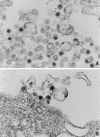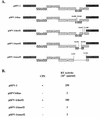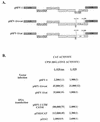Characterization of provirus clones of simian foamy virus type 1
- PMID: 9420293
- PMCID: PMC109442
- DOI: 10.1128/JVI.72.1.817-822.1998
Characterization of provirus clones of simian foamy virus type 1
Abstract
We have cloned proviral DNA of simian foamy virus type 1 (SFV-1) from linear unintegrated DNA (pSFV-1). Transfection of pSFV-1 induces cytopathology in several cell lines with supernatants from the transfected cell culture containing infectious viral particles. Electron microscopy of the transfected cells revealed foamy virus particles. Deletion analysis of pSFV-1 indicated that the transcriptional transactivator (tas) gene located between env and the long terminal repeat is critical for virus replication, whereas the second open reading frame (ORF-2) in this region is dispensable. Although the tas and ORF-2 regions of foamy viruses have significantly diverged, the results presented here suggested that the gene products have similar functions. Recombinant pSFV-1 containing the cat gene was able to transduce the heterologous gene, indicating the utility of SFV-1 as a vector. An infectious clone of SFV-1 which is distantly related to the human foamy virus will provide a means to understand the biology of this unique group of viruses.
Figures




Similar articles
-
The gene expression of human foamy virus does not require a post-transcriptional transactivator.Virology. 1994 Oct;204(1):409-13. doi: 10.1006/viro.1994.1545. Virology. 1994. PMID: 7522374
-
Infectious proviral clones of chimpanzee foamy virus (SFVcpz) generated by long PCR reveal close functional relatedness to human foamy virus.Virology. 1995 Dec 20;214(2):685-9. doi: 10.1006/viro.1995.0086. Virology. 1995. PMID: 8553577
-
Characterization of the internal promoter of simian foamy viruses.J Virol. 1994 Aug;68(8):4811-20. doi: 10.1128/JVI.68.8.4811-4820.1994. J Virol. 1994. PMID: 8035481 Free PMC article.
-
Foamy viruses.Intervirology. 1993;35(1-4):196-207. doi: 10.1159/000150310. Intervirology. 1993. PMID: 8407246 Review.
-
Foamy viruses are unconventional retroviruses.J Virol. 1999 Mar;73(3):1747-55. doi: 10.1128/JVI.73.3.1747-1755.1999. J Virol. 1999. PMID: 9971751 Free PMC article. Review. No abstract available.
Cited by
-
AZT-resistant foamy virus.Virology. 2008 Jan 5;370(1):151-7. doi: 10.1016/j.virol.2007.08.025. Epub 2007 Sep 27. Virology. 2008. PMID: 17904181 Free PMC article.
-
Sensitive assays for simian foamy viruses reveal a high prevalence of infection in commensal, free-ranging Asian monkeys.J Virol. 2007 Jul;81(14):7330-7. doi: 10.1128/JVI.00343-07. Epub 2007 May 2. J Virol. 2007. PMID: 17475645 Free PMC article.
-
Feline foamy virus genome and replication strategy.J Virol. 2003 Nov;77(21):11324-31. doi: 10.1128/jvi.77.21.11324-11331.2003. J Virol. 2003. PMID: 14557618 Free PMC article.
-
Expanded tissue targets for foamy virus replication with simian immunodeficiency virus-induced immunosuppression.J Virol. 2006 Jan;80(2):663-70. doi: 10.1128/JVI.80.2.663-670.2006. J Virol. 2006. PMID: 16378969 Free PMC article.
-
Population dynamics of rhesus macaques and associated foamy virus in Bangladesh.Emerg Microbes Infect. 2013 May;2(5):e29. doi: 10.1038/emi.2013.23. Epub 2013 May 22. Emerg Microbes Infect. 2013. PMID: 26038465 Free PMC article.
References
-
- Barry P A, Pratt-Lowe E, Luciw P A. Electroporation of T-cell and macrophage cell lines. Bio-Rad technical bulletin 1349. Richmond, Calif: Bio-Rad Laboratories; 1989.
Publication types
MeSH terms
Substances
Grants and funding
LinkOut - more resources
Full Text Sources
Miscellaneous

